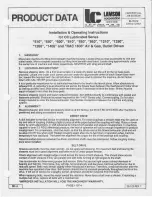
3
©2002 Dresser, Inc. all rights reserved.
ROOTS, RAM, URAI and WHISPAIR are trademarks of Dresser, Inc.
Dresser Design and Universal RAI are registered trademarks of Dresser, Inc.
ROOTS
™
blowers & exhausters are treated after factory
assembly to protect against normal atmospheric
corrosion. The maximum period of internal protection
is considered to be one year under average conditions,
if shipping plugs & seals are not removed. Protection
against chemical or salt water atmosphere is not
provided. Avoid opening the unit until ready to start
installation, as corrosion protection will be quickly lost
due to evaporation.
If there is to be an extended period between installa-
tion and start up, the following steps should be taken
to ensure corrosion protection.
❏
Coat internals of cylinder, gearbox and drive end
bearing reservoir with Nox-Rust VCI-10 or
equivalent. Repeat once a year or as conditions
may require. Nox-Rust VCI-10 is petroleum
soluble and does not have to be removed before
lubricating. It may be obtained from Daubert
Chemical Co., 2000 Spring Rd., Oak Brook, Ill.
60521.
❏
Paint shaft extension, inlet and discharge flanges,
and all other exposed surfaces with Nox-Rust
X-110 or equivalent.
❏
Seal inlet, discharge, and vent openings. It is not
recommended that the unit be set in place, piped
to the system, and allowed to remain idle for
extended periods. If any part is left open to the
atmosphere, the Nox-Rust VCI-10 vapor will
escape and lose its effectiveness.
❏
Protect units from excessive vibration
during storage.
❏
Rotate shaft three or four revolutions every
two weeks.
❏
Prior to start up, remove flange covers on both
inlet and discharge and inspect internals to insure
absence of rust. Check all internal clearances.
Also, at this time, remove gearbox and drive end
bearing cover and inspect gear teeth and bearings
for rust.
Because of the completely enclosed unit design,
location of the installation is generally not a critical
matter. A clean, dry and protected indoor location is
preferred. However, an outdoor location will normally
give satisfactory service. Important requirements are
that the correct grade of lubricating oil be provided for
expected operating temperatures, and that the unit be
located so that routine checking and servicing can be
performed conveniently. Proper care in locating driver
and accessory equipment must also be considered.
I
NSTALLATION
Supervision of the installation by a ROOTS Service
Engineer is not usually required for these units.
Workmen with experience in installing light to
medium weight machinery should be able to produce
satisfactory results. Handling of the equipment needs
to be accomplished with care, and in compliance with
safe practices. Unit mounting must be solid, without
strain or twist, and air piping must be clean, accurately
aligned and properly connected.
Bare-shaft Units: Two methods are used to handle
a unit without base. One is to use lifting lugs bolted
into the top of the unit headplates. Test them first for
tightness and fractures by tapping with a hammer.
In lifting, keep the direction of cable pull on these
bolts as nearly vertical as possible. If lifting lugs are
not available, lifting slings may be passed under the
cylinder adjacent to the headplates. Either method
prevents strain on the extended drive shaft.
Packaged Units: When the unit is furnished mounted
on a baseplate, with or without a driver, use of lifting
slings passing under the base flanges is required.
Arrange these slings so that no strains are placed on
the unit casing or mounting feet, or on any mounted
accessory equipment. DO NOT use the lifting lugs in
the top of the unit headplates.
Before starting the installation, remove plugs, covers
or seals from unit inlet and discharge connections
and inspect the interior completely for foreign material.
If cleaning is required, finish by washing the cylinder,
headplates and impeller thoroughly with a petroleum
solvent. Turn the drive shaft by hand to make sure
that the impellers turn freely at all points. Anti-rust
compound on the connection flanges and drive
shaft extension may also be removed at this time
with the same solvent. Cover the flanges until ready
to connect piping.
Mounting
Care will pay dividends when arranging the unit
mounting. This is especially true when the unit is
a “bare-shaft” unit furnished without a baseplate.
The convenient procedure may be to mount such a
unit directly on a floor or small concrete pad, but
this generally produces the least satisfactory results.
It definitely causes the most problems in leveling and
alignment and may result in a “Soft Foot” condition.
Correct soft foot before operation to avoid unnecessary
loading on the casing and bearings. Direct use of building
structural framing members is not recommended.
For blowers without a base, it is recommended that a
well anchored and carefully leveled steel or cast iron
mounting plate be provided. The plate should be at
Содержание UNIVERSAL RAI Series
Страница 34: ...NOTES...
Страница 35: ......





































